
Back in October I was roving Brooklyn, Queens and Manhattan quite a bit. In the year of Covid, I resumed roaming about, including riding the subways, at first fitfully in June, then switching to a busier schedule in August and continuing on until the end of November. As the Covid positivity rate inched up toward 10% I suspended activities again for the most part (especially riding the subway), though my daily walks continue locally. I have not been in northern Manhattan or the Bronx, and I haven’t been in Staten Island at all. I apologize if FNY’s coverage of either borough has been insufficient the past few months, and when all this virus mishigoss is over, I’ll try to resume touring both boroughs extensively.
In mid-October I found myself in northern Sunset Park and Park Slope, at first examining the mysterious paving stones of 37th Street. The weather was so spectacular, sunny and 63 degrees, that I decided to walk all the way north on 5th Avenue to the Barclays before calling it a day. This is a walk I have done before for FNY, but way back in 2005. On that page, I imparted what history I have for that stretch of 5th, so I won’t repeat myself here: in fact, I think I’ll have plenty of photos on this page with not as much text. (That always makes for a faster composition.)
Along with 3rd and 4th Avenues, 5th is the only north-south numbered avenue in the original City of Brooklyn street numbering system to run continuously from downtown all the way to Bay Ridge. The city of Brooklyn only ran as far south as 60th Street before Brooklyn started gobbling up other towns in Kings County such as New Utrecht (the town in which Bay Ridge was situated) and city and county were coterminous from 1895-1898, when Brooklyn was reluctantly consolidated with Greater New York City.
I should also mention that from the 1880s until 1940, the entire stretch of 5th Avenue I’m depicting on this page was shrouded by an elevated train. At this remove, I’m uncertain why the line was eliminated, but no doubt the 4th Avenue subway (today’s D, N, R), with its express service, leached riders away from it. You can get a good idea of what 5th Avenue was like in its elevated train days in the Municipal Archives.
When I was a kid, I was a bowler and was involved in several school and local leagues all the way into my college years. But I could have used some coaching. I could never master a hook and so settled for heaving the ball down the middle. That resulted in more splits than I would’ve liked and I wasn’t a terrific spare shooter either, and so rarely got my average above 150. I am a lettered athlete, though, as I was on the college team as a sophomore (they were desperate for warm bodies on the team).
Most often, I bowled at Leemark on 88th in Bay Ridge, but I also bowled at Diplomat on Snyder Avenue, Rainbow on Knapp Street, a place on Humboldt Street in Greenpoint whose name I have forgotten, and of course, Bowlmor on University Place in the Village, since moved to Chelsea Piers. I have to say, though, I never bowled at Melody which has been a presence at 5th Avenue and 37th for several decades. Meoldy even boasts a local celeberity, bartender Pete Napolitano, who has been at it here for over 30 years.
Melody Lanes is everything a bowling alley should be. Cheap, filled with entertaining characters and a jukebox crammed with every R.Kelly song you’ll ever need. After you get past the gestapo that runs the front desk head over to the bar where you will meet Peter Carmine Gaetano Napolitano, otherwise known as Pete. I first met Pete two years ago when I had my birthday party at this fine establishment. Done up in a dapper bow-tie and sporting the best side burns this side of the seventies, he is a New York original. His personal concoction, the “Pete’s Special” also known as “one..and she’s done”, is a mystery mix of various rums, food coloring and god knows what else. Pete is a philosopher of sorts and it’s tempting to talk with him the whole night then embarrass yourself with gutter balls. So when I recently made my second pilgrimage to Pete’s bar stool I was an experienced veteran. I coolly asked for the Pete’s special and he responded with, “Lady the last time I did that, they gave me six months for it.” Ah yes, just another gem from this unsuspecting local celebrity. {Broke Ass Stuart]
The Jackie Gleason MTA bus depot at 5th Avenue and 36th Street was built in 1988 and was named for the Brooklyn comic whose perhaps most beloved character was Brooklyn Bus driver Ralph Kramden. The Gleason, one of the major depots in NYC, serves the B8, B9, B11, B16, B23, B35, B37, B61, B63, B65, B67, B68, B69, B70, B71, B75 and B77 lines, serving western and central Brooklyn from Bay Ridge to Crown Heights. There is also a small museum fleet including a 1948 GM and 1956 Mack — the green and white buses I rode on in my youth.
The Gleason depot replaced the large brick 1890 Union Depot, which served the Brooklyn, Bath and West End Railroad (today’s D and M trains) and the Culver (today’s F train). The Union Depot became a subway/el car and bus inspection shop in about 1917 and served that role until 1984, when it was demolished.
The depot’s logo mounted on a plaque resembles the opening title of Gleason’s famed sitcom The Honeymooners.

Green-Wood Cemetery, established in 1838, borders the east side of 5th Avenue from 24th Street south to 36th. I have visited often, the most recent occasion in September 2020, and have had between 5 and 10 Forgotten NY tours here. It’s a favorite oasis for me.

Continuing along 5th Avenue, on either side of 30th Street opposite the cemetery we see the back yards of a group of homes, seemingly turned away from the cemetery as if fearing it. These are a pair of private courts named Woodrow (the south side of 30th) and Roosevelt (the north side). The two courts were constructed in 1922 and the homes originally sold for between $6,950 and $7,500. What’s that in today’s money?
Learning that they were built in 1922 solved one mystery — Roosevelt Court is named for Teddy, though FDR was already well-known, since he was by 1922 a New York State Senator, Secretary of the Navy, and had run unsuccessfully for Vice-President in 1920 as James Cox’s running mate, losing to the Warren G. Harding – Calvin Coolidge ticket.

A row of brick dwellings on 29th Street just off 5th Avenue. Two story brick walkups like this, I call “the bread and butter of Brooklyn residential buildings.”

The Staplex Company (777 5th Avenue, between 28th and 29th) was a staple of my view out the B63 windows as the GM fishbowl buses I rode in rattled down 5th Avenue in the 1970s, and they’re still there today. As you’d probably expect Staplex makes automatic electric staplers but also high volume, asbestos & lead air sampling equipment.
The old man was a tape recording enthusiast, belonging to several clubs that sent reel to reel voice and music recordings worldwide. (Had he ever met Louis Armstrong, they would have found common ground as Satchmo was also a tape recording devotee). In the 1970s he switched to cassette tapes, but with reel to reel his brands of choice were Scotch and BASF.
N.R.S., #764 5th Avenue between 26th and 27th Streets, which has an online presence at tapes.com, was founded a bit late for my father, in 1992.
From the beginning NRS was the leading supplier of blank audio cassette tapes, studio mastering tape and duplicating supplies to every major record label and duplication facility in New York City and the continental US. Chances are if you put out a demo tape back then we supplied the blank tape for it!
As the industry started leaning more towards digital formats NRS made the transition as a dealer for all the major digital brands while still maintaining its cassette loading equipment. [Tapes.com]

Baked in Brooklyn was established at #755 5th, at 26th Street, about a decade ago and is actually popular with cemetery visitors. Bread and other baked goods is produced in their onsite plant 365 days a year.
I was fascinated by this photo as despite it being a color picture, there isn’t speck of color in it! Just white, black and gray. The exterior of the building is all gray with a neon sign.

As long as I can remember, the block defined by 5th and 6th Avenues, 23rd and 24th Streets has featured a Con Ed substation, but if you look at this 1929 atlas, it used to be a trolley car barn/depot.
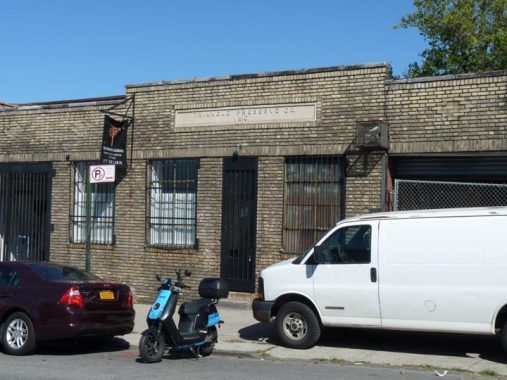
The former Triangle Preserve Co., #299 24th Street off of 5th Avenue. “Jam,” “jelly” and “preserves” are sometimes used interchangeably, but Britannica lays out the differences here:
Jelly has the smoothest consistency and is made by crushing a fruit and discarding the solid chunky leftovers. This leaves only the fruit juice, which is then mixed with a substance called pectin and heated to form the gelatinous spread. Jam is similarly made by crushing a fruit, but this spread leaves in most of the solid pieces of the fruit’s fibers and seeds (if they’re small enough and safe to consume) to give it a spreadable consistency. Of the three, preserves use the most of the fruit and are simply chopped smaller pieces of fruit that are mixed with sugar to keep them fresh and combined with a syrup or jam to contain them.

We’re entering a section of 5th Avenue in South Park Slope I don’t necessarily know a lot about, but there’s a lot of vintage signs and new ones that are interesting. At #706 5th, at 22nd Street, is AC Realty, ran by Ffatigato & Camberlango. Unless that’s a misprint, I’ve never before seen an Italian name beginning with 2 Fs. Welsh, yes, but not Italian.

Nicol’s Unisex salon’s sign at #705 5th is in the Belwe font, distinctive for its flaglike swashes.
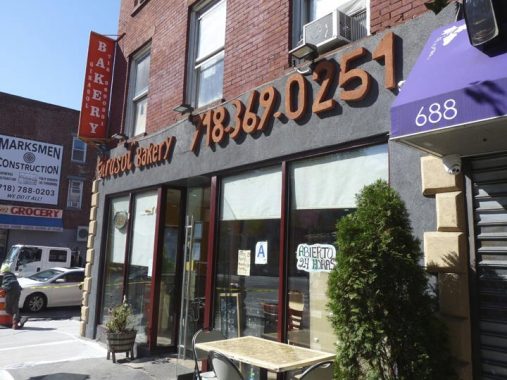
And how about these wood cutout letters on the Girasol Bakery sign, #690 5th Avenue at 21st Street. I seem to remember them as a 5th Avenue mainstay from way back.

Speaking of mainstays, Luigi’s, at #686 5th, was founded by Luigi Lonzo in 1973. His son now runs the pizzeria, which still has its old school red, white and green plastic sign. The interior was featured in the Adam Sandler film Big Daddy.

How do you ruin a perfectly good 3-story brick walkup at 5th Avenue at 20th Street? Stick a ridiculous looking penthouse on top of it.

A former furniture store at 5th and 19th appears to be an old theater. I noticed a faded sign on it advertising an old appliances chain, Friendly Frost; before P.C. Richard ascended to its current domination around town, there was Friendly Frost and later, Newmark & Lewis and the Wiz in the 1970s and into the 90s.
The 1896 Hutwelker Building at 5th and 19th. You have to wonder why these elaborate building identifications were placed at the top, where no one could see them unless you happened to be looking up, or in a building across the street. But there may be an answer to this…
Here’s what the corner looked like in 1940. As you can see, the 5th Avenue El was shrouding the avenue in its final year of service, as it had done since it was extended past 19th Street in 1889. At the time, spotting that “Hutwelker Building” sign on the pediment would have been tough… unless you could do it from a station platform. As it happened, the el had a stop at 20th Street, so that may have been the case.
Frederick Hutwelker operated a pork packing enterprise with his two brothers beginning in 1896 (the business was physically located on the Hudson River waterfront in the West 40s in Hell’s Kitchen, which had its own stockyards district in the late 19th-early 20th Century).
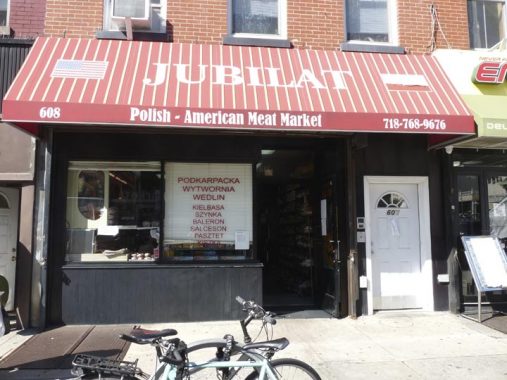
While Greenpoint and Maspeth have a much more storied concentration of Poles, Slovaks and Eastern European immigrants, there’s also a large contingent here along Fifth between about Prospect Avenue and 25th Street, mixed with a Hispanic complement and a newer Asian movement. The late lamented Eagle Provisions at 5th and 18th once specialized in kielbasa and over 1600 varieties of beer.
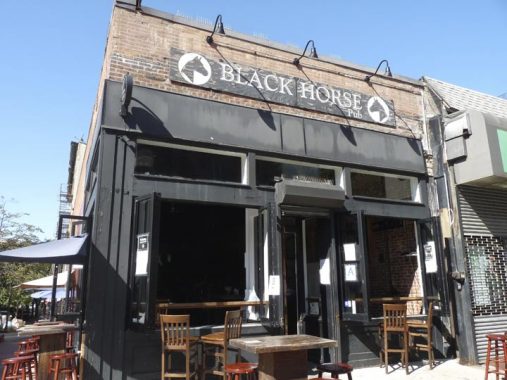
I haven’t been in the Black Horse Pub, #568 5th Avenue at 16th Street, but I do like their sign, which uses the Goudy Handtooled font.
I know this building, #555 5th Avenue at 15th Street, home to a paint store and a gym, had originally been a bank. The only remaining visual clue is a sailing ship bas-relief. Which bank? The Comments section is open.

#480 5th Avenue, at 11th Street, looks like a survivor from the 19th Century with its slanted roof and dormer windows. It may have predated the 1889 5th Avenue El.
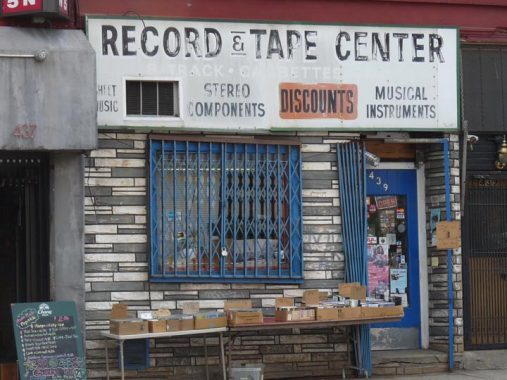
The shop’s iconic handlettered sign is gone, but recent (2020) Yelp reviews indicate that Record & Tape Center, #439 5th Avenue just off 9th Street, is still in business; a 2014 Daily News article (subscription-only; so I won’t link) indicated the end had been near that year. Some of the cracked vinyl displayed outside is shown here.
A sampler of some of the residential housing on 7th Street just off 5th Avenue. This falls outside Park Slope’s Landmarked district, and new buildings are interspersed with the old. Funny how some architects design buildings to have vague human faces with the window arrangements.

The late Joe & Flo Leopoldi are honored for their service to the Park Slope community with a street sign. In 1966 they opened Leopoldi’s Hardware at #415 5th, which still has an old-school sign, seen here.

Another old-school painted sign that’s still in place at #378 5th Avenue near 6th Street, Botánica Universal Las Mercedes. Are botánicas unique to NYC? It’s a religious goods store that sells materials associated with both the Catholic Church and Santeria. Strictly speaking “botánica” means “plant store” and botánicas also sell medicinal herbs.
Botánicas extend centuries-old practices of using plants and herbs to treat and heal illnesses. According to scholar Jules Janick, botánicas have their roots in the relationship of the Aztecs of Mexico and the Spaniards. The Aztecs showed the Spaniards their methods to healing, such as which plants had curative properties and how to use them. Soon after, the Spaniards began to keep records of the names of the plants and their uses. These practices continued and evolved as household remedies during and after the Spanish conquest. Generally a person who practiced the art of folk healing became known as a curandero, with the practice known as Curanderismo [wikipedia]
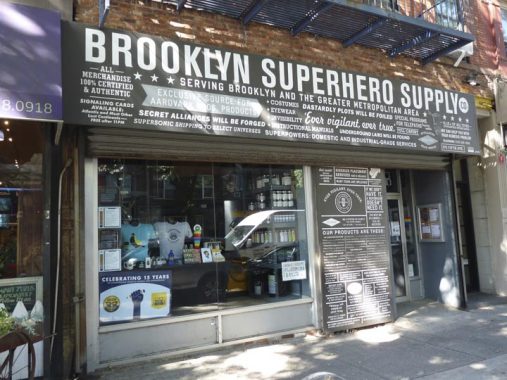
When I passed this storefront at #372 5th Avenue near 6th Street, I assumed it was an elaborate movie set or an expensive joke, but it turns out “Brooklyn Superhero Supply” is a spiffed-up tutoring center for neighborhood kids, known as 826nyc, that opened in June 2004. Why 826? It’s an offshoot of an original center on 826 Valencia Street in San Francisco. It was started by belles-letterman Dave Eggers.
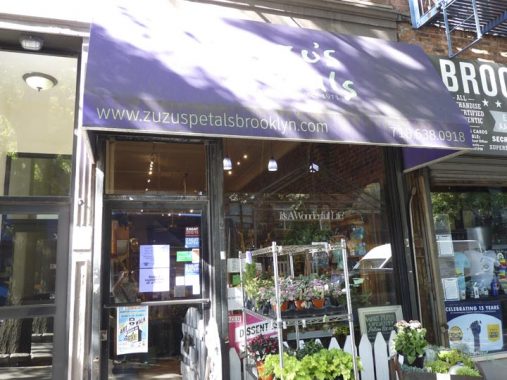
Next door, it’s Christmas all year for this florist, which references “It’s a Wonderful Life.”

At #375A, Logan’s Run must not admit anyone over 30 (the 1976 sci-fi classic is set in a future earth in which everyone reaching age 30 is eliminated. Logan, played by Michael York, is a police officer who catches “runners,” discovers an outside world and the only person on earth over the age of 30, played by Peter Ustinov).

An exposed wall at 5th Avenue and 1st Street displays the unmistakable script of Charles H. Fletcher, whose children’s laxatives’ ads were on hundreds, perhaps thousands, of buildings in the late 1800s to early 1900s.
A pair of unusually-positioned fire alarm indicators. Usually, they’re further down on the shaft; and they’re usually not mounted on stoplights. Both, however, have not been serviced in years and no longer light up at night.

Macomb Street, running between 4th Avenue and Prospect Park West, was probably named for Alexander Macomb Sr. (1748-1831), a prosperous Revolution-era merchant born in Belfast, Ireland. Though he initially had Tory sympathies he built the mansion George Washington occupied in NYC between 1788-1790 when the US Capitol was located in Manhattan. Macomb owned large upstate tracts.
Macomb Street was renamed Garfield Place after the US President James Garfield‘s assassination in 1881, which marks the chiseled sign, and the building it’s on, as particularly elderly. Garfield was not initially killed by the bullet’s impact, but by treatment with unsterilized instruments, resulting in blood poisoning.
Recently, the building’s owners have touched up the chiseled names on the quoins and painted the names in black, making them more visible.

Fjord, a fish market at #249 5th Avenue near Carroll, makes use of a fish hook for the “J.” A fjord, pronounced “fee-yord,” is simply what they call inlets in Norway.

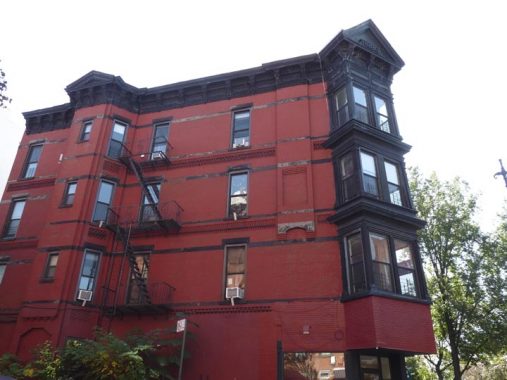
A number of Park Slope corners along 5th and 7th Avenue boast these corners win which the windows face 3 directions, allowing plenty of different vistas. In this case, the date of construction, 1886, is emblazoned on the pediment. The El would come along in 1889, spoiling the view somewhat, but if residents waited long enough (to 1940!) they got the view back. A second such corner is at the other end of the block, at President Street.

Simply Greek, a restaurant at #242 5th Avenue near Carroll, employs the Bernhard Modern font, which you may recognize from its use in the “Twilight Zone” TV credits, both in the 1960s and in the newer version.

Luke’s Lobster is one of a chain of eateries, called “shacks” in company nomenclature, at #237 5th Avenue. I liked the “distressed” painted sign.
There has been an empty lot at 5th and President Street for decades that has been used as a community “green space.” The sign is fairly frank about why it’s not open at present.
Another handsome handcrafted sign at Fleisher’s, #192 5th Avenue near Sackett Street. This is an entry in a chain of craft butcher shops. The website is silent on who founded it, but fleischer is German for “butcher.” Why they left out the c is up for conjecture.
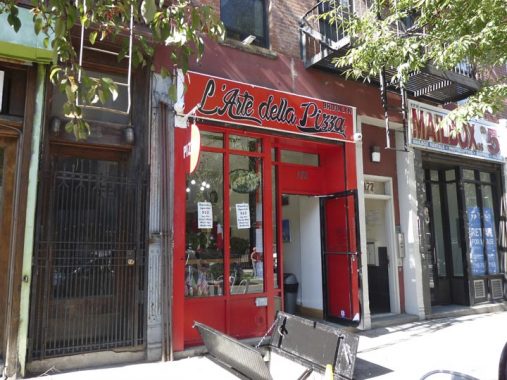
I haven’t sampled The Art of Pizza, #172 5th Avenue, between Sackett and DeGraw, but that’s one heck of a sidewalk presentation. Just don’t fall into the basement.
A collection of sidewalk shingle signs on northern 5th Avenue.
I’m tempted to do a feature on the outdoor dining sheds that have sprung up during the Covid crisis; indoor restaurant dining has been banned while the infection rate rate is high. Most of these are jury rigged, as they are not yet considered permanent. I have never been an al fresco devotee. The traffic noise, the other distractions, the heat, the cold, not something I enjoy.

Key Food, at 5th Avenue and Baltic Street, has been part of the northern Park Slope scene since just after I graduated college in the early 1980s; a developer has been threatening to buy it and demolish it, but it was still thriving in October 2020. In my opinion, its arrival was key in beginning to transform 5th Avenue from a bullet riddled drug haven into something more livable; its subsequent gentrification is another story.
When the Key Food was built a short street was created between Butler and Baltic Streets: a short street with a very long name, Quisenbury Drive/Gregory Place. The name is in the tradition of one-block NYC streets with lengthy names like Taras Shevchenko Place (East Village) and Shaughnessy and Kaltenmeier Lanes (Rosebank, Staten Island).
Quisenbury Drive was named in 1988 for longtime Fifth Avenue Committee president Dorothy Quisenbury; not sure about Gregory.

Flatbush Avenue cuts through Park Slope grid at an angle, creating many irregular plots. Triangle Sports had occupied the only building in the triangle-shaped plot here at Flatbush, 5th and Dean for nearly 60 years (the actual building, though, has four sides). Triangle also had a Bay Ridge branch on 83rd and 5th for many years; my mother bought my Cub Scout uniforms there.

McMahon’s features that favorite of Gen Xers and Millennials, karaoke, but for decades, it was O’Connor’s, where generations of hard drinking old men gathered and fulminated about the old days.
Around the corner is Barclays Center. Here’s what used to be there.
Check out the ForgottenBook, take a look at the gift shop, and as always, “comment…as you see fit.”
1/11/21

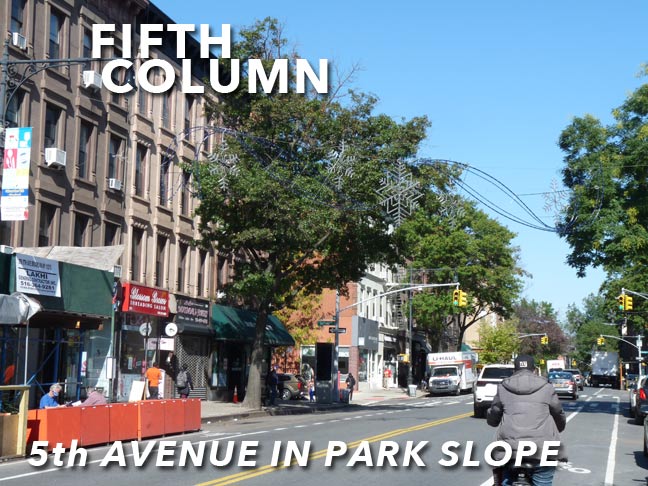
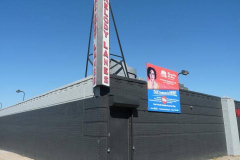
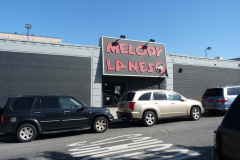

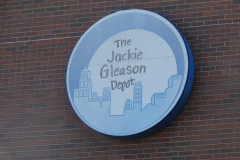
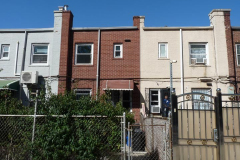
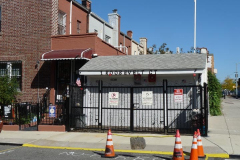

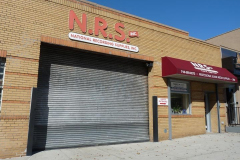
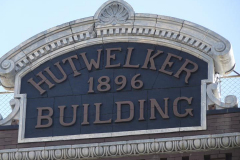
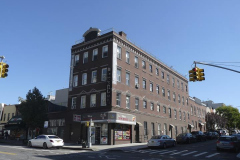
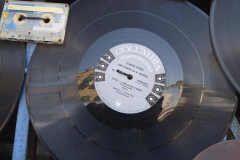


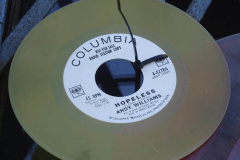

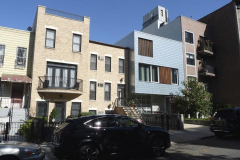


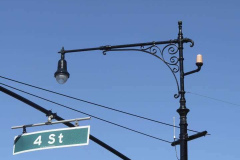
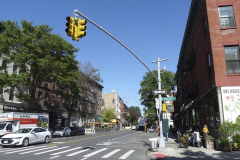

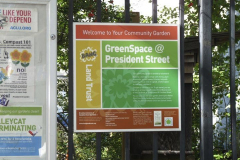

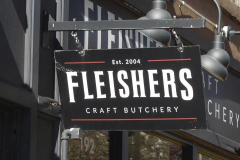
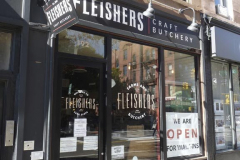
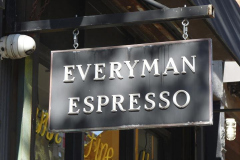
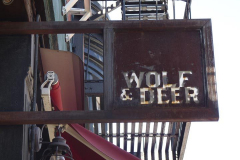
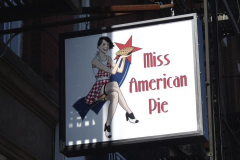
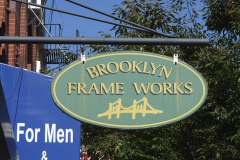
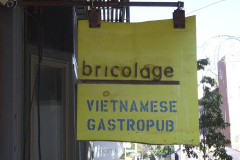
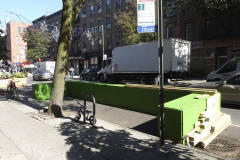

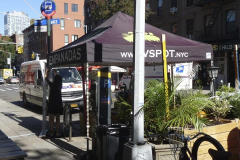
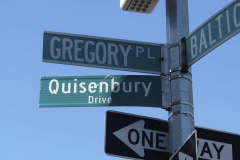
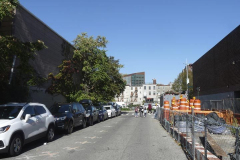
12 comments
A nice view of “The Willie” rising in the background behind Key Food, and a Downtown Brooklyn fixture for nearly 100 years.
Most likely the 5th Avenue El was discontinued because service ended over the Brooklyn Bridge. Without Manhattan service and the subway a block away ridership probably dropped.
Garfield did not die because of unsterilized instruments, but from something much worse: dir fingers. After Charles Guiteau shot the president in a train station (not Union Station but the long gone Baltimore & Potomac station), his Secretary of War Robert Todd Lincoln, Abe’s son, summoned a prominent Washington doctor named Doctor Doctor Willard Bliss to the White House. That is not a mistake; his first name actually was Doctor, though he usually went by his middle name Willard. Bliss probed the wound channel with his fingers, which he hadn’t even bothered to wash. While doctors hadn’t fully grasped the importance of sterility in 1881 Bliss’s old-school disregard of basic cleanliness was largely in disrepute and earned him a great deal of criticism. It also lead to the massive infection that proved fatal a couple of months later.
Fun fact: Bliss’s disregard of basic cleanliness didn’t stop him from presenting the government with an enormous bill for his services. He didn’t get paid.
Additional fun fact: When Guiteau went on trial he claimed that at most he was guilty of assault but not murder, because Garfield actually died from medical incompetence. It didn’t save him from a necktie party.
Bonus rail related content: As Garfield lay dying in the White House his doctors – probably not including Bliss, who had been more or less pushed aside by this point – decided to move him to a seaside cottage in Elberon, New Jersey, in the hope that the fresh ocean air would help his recovery. One issue soon arose, as the cottage was about a half mile from the New York & Long Branch tracks (today the NJCL) and the idea of moving the desperately ill president that far in a horsedrawn ambulance seemed inadvisable. Elberon’s citizens leapt into action and in about 24 hours built a crude but serviceable temporary track almost to the cottage door. Unfortunately, Garfield died a couple weeks later. The track, never meant for permanent use, was torn up soon afterwards, but a local actor used some of the ties to build a cottage known as the Garfield Tea Room that still stands today.
I couldn’t seem to turn up any bank references for 555 5th Avenue, but I did come across an organization called the Brooklyn Britannia Benefit Society for which such a ship symbology may make sense.
Botanicas are all over the country
Seamen’s Bank for Savings?
Two things…..
A “fjord” isn’t just a simple inlet; it’s a river valley/estuary carved out by glaciers. The distinguishing characteristic is that due to the scouring of the glacier, the inlet/estuary is at its deepest “upstream” from the river mouth. Since the Hudson River a) was carved out by glaciers for the most part, and b) tidal currents go way upstream – past Peekskill, and c) it’s deepest point is in the Highlands near West Point, the Lower Hudson qualifies as a fjord.
https://www.dec.ny.gov/lands/66611.html
“Brooklyn Superhero Supply” reminds me of Villain Source (originally known as Villain Supply), the website for all your villainous needs. Well, before the International Association of Do-Gooders got the site shut down. These days, you can only find it through the Wayback Machine:
https://web.archive.org/web/20110426021516/http://villainsource.com/
Marine Midland Bank?
Marine Midland Bank?
I used to live in PA – the Lehigh valley area. There were n still r a lot of botanicas there. The area boasts a large Latino population. The botanicas are connected to these populations.
https://maps.google.com/maps?oe=UTF-8&hl=en-us&client=safari&q=botanica+allentown&um=1&ie=UTF-8&sa=X&ved=2ahUKEwif_eDniZzuAhUDFFkFHWjaCOQQ_AUoAXoECAMQAQ
Nice piece Kevin! You brought back many memories. I lived on 32nd between 4th and 5th from 89- 98. Lots of shopping at Eagle Provisions and plenty of drinking at O’Connors when it wasn’t cool to drink in old man bars.
Re 706 5th Ave, and “Ffigato”
Seeing letters had fallen off the sign, and that the name of the agency is “A C”, if C stands for Camberlango, A must stand for Affigato, whose initial A had fallen off. Googling the two names verified the theory, but I can’t post the screenshot.